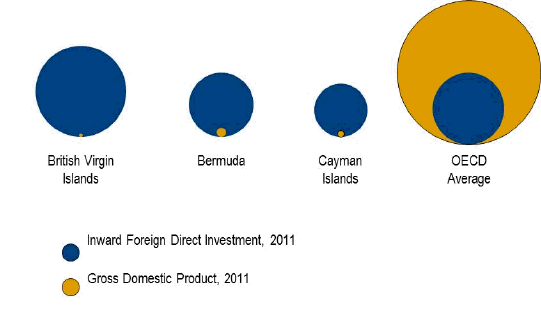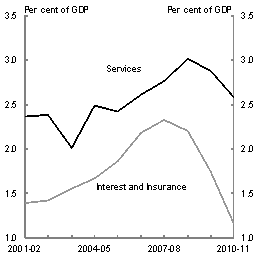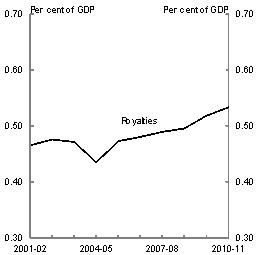- One aspect of the risk to Australia's corporate tax base is the extent to which it is currently being affected by base erosion and profit shifting. The May 2013 Issues Paper examined this question, and sought submissions on whether there was evidence of base erosion and profit shifting in Australia, including what additional data might be required to reach a definitive conclusion.
- It is also important to clearly understand the extent of the risk that has been identified internationally. This is because international trends may highlight actual or potential risks to the Australian corporate tax system and because it may explain actions that are or will be undertaken by the international community in this area.
- Perhaps even more important is the question of how the risks to Australia's corporate tax base may have changed (and may be changing) over time. Broadly, this requires an assessment of trends in the sources of risks identified in the previous Chapter, and how they are changing over time, and the effectiveness of measures taken domestically and internationally to mitigate these risks.
5.1 Evidence of Base Erosion and Profit Shifting in Australia
- The Issues Paper noted that a significant conceptual challenge in assessing the level of erosion of the corporate tax base was establishing a relevant benchmark. While a common approach is to analyse aggregate trends in corporate tax collections, it is difficult to isolate the impact of tax planning strategies from other factors. The usefulness of analysis of effective tax rates of companies is limited by the potential for profit shifting to affect both tax and accounting income and the need to isolate the impact of policy decisions on the tax base. More detailed data on specific areas of risk of base erosion could provide a more useful indicator of the emergence of risk over time, but data limitations mean that it can be difficult to extrapolate from available data to draw conclusions on the aggregate extent of the issue.
- Submissions on the Issues Paper from business representatives and the tax profession generally expressed the view that there was little evidence of widespread erosion of the Australian corporate tax base from tax minimisation activity by multinational enterprises.12 A number of submissions made similar points to this statement by the American Chamber of Commerce in Australia:13
Australia is very well known internationally as having a highly effective set of tax laws to protect Australian Revenue. The ATO is widely known as being one of the more effective and skilful tax administrations within the members of the OECD.
- A number of submissions also highlighted the role of Australia's dividend imputation system in encouraging compliance by Australian listed and owned companies.14 More generally, the Institute of Chartered Accountants in Australia stated that:15
The prevailing culture within the economy, including multinationals, and society more widely is one of compliance with Australia's tax laws. Tax crime and evasion are at the margins of economic activity.
- Submissions also generally accepted the arguments in the Issues Paper that effective tax rate calculations were of limited value in assessing the extent of profit shifting by multinational enterprises.
- There was, however, general agreement that the rise of the digital economy and the increased importance of intangibles presented challenges to the tax base of countries generally, including Australia.
- The Tax Justice Network attributed the lack of clear evidence of base erosion and profit shifting in Australia to the high level of confidentiality of taxpayer affairs restricting the level of information in the public domain. A consistent message from submissions was that greater use should be made of information currently provided to the ATO before any additional data was sought to address information gaps.
- In any case, the extent to which Australia's corporate tax base is currently being affected by base erosion and profit shifting is only one aspect of the level of risk to Australia's corporate tax base. As one submission noted 'evidence of the precise extent of BEPS would be helpful but is not essential; the fact that BEPS can occur is enough to justify attempting to set the rules correctly'.16
- The evidence that Australia has one of the more effective corporate tax systems in the OECD means corporate tax has a more important role in Australia's tax system than that of many other countries. As such, efforts to address the risk of base erosion and profit shifting in Australia should primarily focus on protecting the existing corporate tax base.
5.2 International Evidence of Corporate Tax Base Erosion
- As in the Australian context, the analysis undertaken to date on the available evidence of the magnitude and growth of global corporate tax base erosion is mixed.
- On the one hand, several submissions on the Issues Paper expressed a similar sentiment to that put by tax academics from the University of New South Wales that pointed to the 'ample evidence that base erosion and profit shifting is occurring internationally' as indicating that this activity would also be present in Australia.17
- However, the OECD report suggests a more cautious interpretation of the existing international evidence (OECD, 2013).
5.2.1 Global Effective Tax Rates of Multinational Enterprises
- In theory, analysis of the global effective tax rates of multinational enterprises should provide evidence of the extent to which profits had been shifted to low tax jurisdictions. Undertaking these calculations at the global level overcomes a key limitation of country-level effective tax rate analysis — the potential for profit shifting to affect both tax and accounting income.
- In practice, despite some high-profile examples of low global effective tax rates, the OECD concluded that it is questionable whether estimates of global effective tax rates 'provide conclusive evidence that base erosion and profit shifting behaviours are evident'. A key challenge is that effective tax rate calculations 'conflate a number of factors', including policy decisions of national governments, that make it difficult to isolate the reason for variations in global effective tax rates between companies (OECD, 2013). Another challenge is the significant variation in methodology employed in the literature, making comparisons very difficult.
5.2.2 Patterns of Foreign Direct Investment
- Patterns of foreign direct investment can also provide evidence of the level of base erosion and profit shifting internationally. Channelling foreign direct investment through low or no tax jurisdictions, or special purpose entities, could be indicative of base erosion and profit shifting activity.
- International Monetary Fund data on the source and destination of foreign direct investment highlights that the level of foreign direct investment channelled through some low or no tax jurisdictions is vastly disproportionate to their size — and that this investment has not led to any commensurate increase in domestic economic activity (Chart 6). Analysis of the proportion of corporate profits allocated to these jurisdictions presents a similar picture.18 As Gordon and MacKie-Mason noted:
Observed investment and profit rates in low-tax coun
tries are almost certainly explained by the ease with which a multinational can shift its accounting profits from high-tax to low-tax jurisdictions.
(Gordon & MacKie-Mason, 1994, p. 68)
Chart 6: Foreign Direct Investment and GDP

- Nevertheless, the OECD cautions that while the use of these jurisdictions for holding or intra-group financing warrants further examination, it does not of itself necessarily 'imply that they are being used for base erosion and profit shifting' (OECD, 2013).
5.2.3 Corporate Tax Trends in OECD Countries
- Another potential indicator of base erosion in OECD countries is the relationship of corporate income tax to GDP over time. If base erosion was becoming a larger issue over time then, all else being equal, corporate tax would be expected to decline as a share of GDP over time. However, the OECD observes that the unweighted average of revenues from corporate income tax as a share of GDP has generally been rising over time, despite statutory corporate tax rates falling across the OECD (Sørensen, 2007).
- An important caveat on this analysis is that it does not control for several factors that could obscure any impact from base erosion and profit shifting. In particular, the share of GDP attributable to corporate profits has been rising over time in many OECD countries, and corporate tax bases have been broadened as 'tax expenditures' have been reduced.
- Overall, the view that corporate income tax collections would inevitably decline over time in response to increased mobility of capital, as countries compete to lower the cost of capital within their jurisdictions, is not borne out by the data to date (Devereux, et al., 2004). Among other things this may reflect the fact that capital is not, in reality, completely mobile and the fact that tax competition impacts countries differently (Troeger, 2013).
5.2.4 Location and Reporting of Economic Activity for Tax Purposes
- A number of studies have sought to assess the extent of base erosion and profit shifting activities by comparing the location of 'actual business activities' and where profits are reported for tax purposes (OECD, 2013, p. Annex B).
- An econometric analysis using value added data from 16 OECD countries found evidence suggesting that a substantial share of revenues from a unilateral increase in the corporate tax rate by a country is lost because of a decline in reported income due to profit shifting (Bartelsman & Beetsma, 2003).
- Studies using data from taxpayer returns have found evidence that profits had been shifted to low-tax jurisdictions, particularly as a result of the difficulties in pricing intellectual property (McDonald, 2008). Similarly, a meta-analysis of 23 studies on profit shifting behaviour by multinational enterprises found indirect evidence of profit shifting to low-tax jurisdictions, attributing this primarily to (non-arm's length) transfer pricing and licencing (Heckemeyer & Overesch, 2012).
- The OECD observes that these studies generally conclude that profits, particularly those derived from 'mobile activities' are shifted for tax purposes to where they benefit from more favourable tax treatment, and that this gap has risen over time. Nevertheless, the OECD concludes that these studies are no more than 'circumstantial evidence of the existence of base erosion and profit shifting', due to the difficulty in ensuring the completeness and comparability of data (OECD, 2013).
5.3 Trends in Sources of Risk
- Another way of assessing how the risks to Australia's corporate tax base may have changed (and may be changing) over time is to analyse trends in the underlying sources of risks identified in the previous Chapter.
- These risks arise from entrenched structural features of the corporate tax system, including tax treaties; globalisation and tax competition; and changes in the global economy, including the rise of the digital economy and the global reach of multinationals.
- There is a consistent view in the academic literature and official studies that these risks have been rising.
- In a recent article commenting on the Mirrlees review of taxation conducted in the UK, Alan Auerbach identifies three issues for the US. First, the growth in importance of multinational enterprises (which now account for around 25 per cent of world GDP) has made the treatment of international capital flows a key issue of first-order importance. Second, financial innovation has increased the ability of corporations to exploit differences in the tax treatment of debt and equity. Finally, the corporate-noncorporate boundary has shifted, with a much greater share of business activity and income escaping the traditional corporate form and the corporate income tax (Auerbach, 2012, p. 15).
- The global reach of multinational enterprises is also evident in strategies that seek to exploit gaps and inconsistencies in tax treaties between countries. Such schemes have seen the rise of 'stateless income', which is argued to pose an increasing challenge to the tax sovereignty of national governments (Kleinbard, 2011), or situations where tax treaties delegate residency to the domestic rules of the countries, enabling multinational enterprises to create 'stateless entities'.19
- Our treaties are an important feature of our international tax architecture and provide significant benefits to Australia, however, the risks associated with the treaty network are growing and we need to be aware of the factors driving those risks. Some tax planning structures utilise the sequencing of transactions through jurisdictions to take advantage of treaty provisions or avoid treaty limitations. Tax planning, like many other innovative products or services, is able to be diffused and replicated readily.
- The size of the treaty network is also a risk. The global treaty network, rather than simply the Australian network, present opportunities for structures that can shift profits out of Australia. The size of the treaty network presents challenges around ensuring our own treaties continue to serve the national interest but also in relation to limitations on our ability to influence the bilateral treaties of other countries. Finally the rapid adoption of technology by business does not sit well with the slow pace at which countries, and the international community more broadly, change their treaty practice.
- A key concern is that tax planning techniques developed as a result of these strategies are becoming more prevalent over time. That is, there is a product life cycle of tax planning techniques, whereby the longer they are able to be used without being challenged the more they will be seen as acceptable and used more broadly through the community. Moreover, 'in competitive markets whatever is possible becomes necessary' (Shaxson, 2012, p. 130). This could help to explain the OECD's conclusion that 'a number of indicators show that the tax practices of some multinational companies have become more aggressive over time' (OECD, 2013, p. 6).
- The Issues Paper documented the growing integration of production in global supply chains and the increasing share of value added in advanced economies being der
ived from intangible assets. While these are clearly developments for global prosperity generally, they also pose significant challenges to the tax systems of individual countries, with a number of studies pointing to a rising level of 'mobile rents'. Cross border intra-firm dealings reported by taxpayers in Australia have shown a strong upward trend over the past decade, although this was affected by the onset of the Global Financial Crisis, particularly in relation to related party interest and insurance payments (seeChart 7).
Chart 7: Intra-firm dealings
Services, Interest and Insurance

Royalties

- Similarly, while the continued growth in the scale and scope of the digital economy is overwhelmingly positive for community welfare, in the absence of an updated international tax framework this growth poses significant risks to the corporate tax bases of countries. The implications for the tax system as a growing number of industries 'digitise', particularly those providing services to business, are not well understood but potentially significant as they affect, either directly or indirectly, all sectors of the economy.
- While OECD countries have committed to action to address harmful tax practices, the effectiveness of these measures has been constrained by the use of a very limited definition of a harmful tax practice. Among other things, to be harmful a measure is required to provide preferential treatment (such as a lower tax rate than would generally apply in a country) and be subject to ring-fencing to protect the domestic tax base (such as being limited to non-residents or offshore activity). However, this definition does not address situations where a country explicitly decides to adopt a harmful tax regime, where it gives up its some of corporate tax base in order to attract 'mobile rents' from other countries.
12 See for example submissions by PriceWaterhouseCoopers, Ernst &Young and the Tax Institute of Australia, 2013, Submission to Issues Paper – Implications for the Modern Global Economy for the Taxation of Multinational Enterprises, May 2013.
13 American Chamber of Commerce in Australia, 2013, Response to the Treasury Issues Paper: Implications of the Modern Global Economy for Taxation of Multinational Enterprises, 6 June 2013, p.2.
14 For example, in its submission to the issues paper, Ernst & Young noted that 'Australia's dividend imputation system means that the likelihood of BEPS activity by Australian listed public companies is substantially less than arises in other countries'.
15 Institute of Chartered Accountants Australia, 2013, Issues Paper on Implications of the Modern Global Economy for the Taxation of Multinational Enterprises, 31 May 2013.
16 See joint submission by John Taylor, Michael Walpole, Kathrin Bain, Dale Baccabella, and Nolan Sharkey, 2013, Submission to Issues Paper – Implications for the Modern Global Economy for the Taxation of Multinational Enterprises, May 2013.
17 Ibid.
18 See, for example, (Grevelle, 2013).
19 US Senate Permanent Subcommittee on Investigations on Offshore Profit Shifting and the US Tax Code.